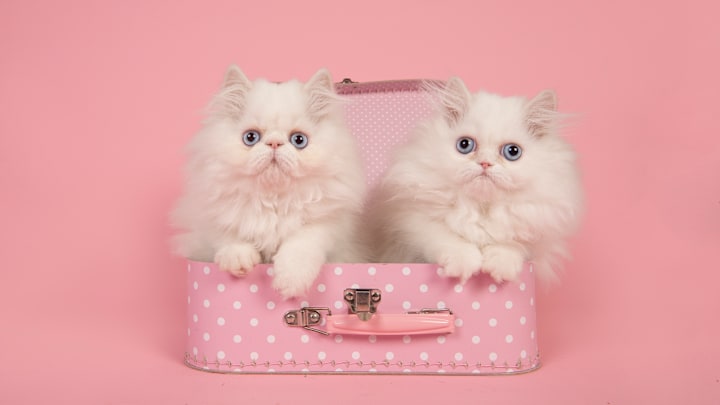With their trademark round faces, stocky bodies, and sumptuous coats, Persians are one of the most recognized cat breeds in the world. Here are a few facts about the fancy feline.
1. Persian cats were a traveler's souvenir.
Like many breeds, the Persian cat’s origins are a mystery. According to some sources, longhaired cats have existed in the Middle East for thousands of years—although research indicates that the kitties have genetics in common with cats from Western Europe.
Although nobody quite knows when—or how—the rest of the world discovered Persian cats, one popular version is that the luxuriously furred feline was introduced to Western Europe by an Italian named Pietro della Valle. Della Valle was a famous nobleman who journeyed extensively throughout the Holy Land, the Middle East, northern Africa, and India. In 1620, della Valle passed through Persia—now known as Iran—and took a liking to the exotic, longhaired gray cats he spotted at a bazaar. He purchased four pairs of them, and brought them home with him to Europe. Of course, sailors, travelers, or merchants might have also carried Persians with them from the Middle East to the Continent.
2. They were in the world's first cat show.
More than 250 years later, Persians took London by storm when the breed was showcased in the world's first organized cat show in 1871 at the Crystal Palace. The day-long exhibition also featured Siamese cats, a Scottish Wild Cat, and Manxes, among other exotic felines. Proving that cats were popular long before the internet, the event drew more than 20,000 visitors. It also shouldn't surprise anyone that a Persian kitten won "Best in Show."
3. Persian cats are beloved in America ...

Sometime after 1895, Persians were brought to the United States. In 1906, the Cat Fanciers' Association was formed in America, and a Persian was one of the first cats registered. Today, the Persian is one of the most popular cat breeds—and most expensive—in the U.S.
4. ... And adored by famous historical figures.
Throughout history, many famous individuals have owned Persian cats. Florence Nightingale had 60 cats in her lifetime, and doted on a large Persian named Mr. Bismarck. Marilyn Monroe owned a white Persian cat named Mitsou. And Raymond Chandler reportedly read the first drafts of his novels to his most discerning critic, a black Persian named Taki.
5. Persian cats are pretty easygoing.
Persians might look prissy and aloof, but they’re actually considered to be one of the most laid-back—and friendliest—cat breeds. They do, however, need careful grooming [PDF].
6. Persian cats come in many sizes, colors, and varieties.

While iconic pop culture Persians are usually white or silver (think the Fancy Feast cat), the breed comes in a range of colors and shades. From tortoiseshell and calico to orange, grey, and black-and-white, the varieties are plentiful. Other sub-variants of the Persian include toy and teacup sizes, Himalayans—which are a cross between a Persian and a Siamese—and Chinchilla Longhairs, which have pointy noses and black-tipped fur.
7. Persian cats are pop culture icons.
Speaking of the Fancy Feast cat, the Persian is perhaps one of the most well-represented breeds in popular culture. James Bond supervillain Ernst Stavro Blofield and his parody alter-ego, Dr. Evil, both love stroking their white, blue-eyed Persians. (Spoiler alert: Mr. Bigglesworth’s lush fur freezes off in a sad—yet hilarious—plot twist.) The 2001 movie Cats & Dogs features a diabolical Persian named Kitty Galore. Also, a species of Pokémon is named after the Persian.
8. Their faces haven't always been—and aren't always—flat.
After its coat, the Persian’s most distinctive characteristic is its flat face. However, the breed hasn’t always had a squished visage. Persians once had a more pronounced muzzle, but in the 1950s a genetic mutation caused a batch of kittens to be born with scrunched features. Breeders liked the aesthetic, and over the years they used selective breeding to taper down the cat’s silhouette.
Some kitties, called “traditional” or “doll-face” Persians, still look like their pointy-featured ancestors. Others have a “peke-face,” or an “ultra face,” which describes the kind of smushed-in mug the Persian is known for today. The Cat Fanciers' Association views the peke or ultra-faced Persian as the breed’s modern standard [PDF]. However, it comes with a price: Persians with this feature have runny eyes, labored breathing, and often struggle to eat their food.
9. Persian cats have been immortalized in art.

In 2015 a 6-by-8.5-foot artwork that’s purported to be the “world’s largest cat painting” sold at auction for more than $820,000. The late 19th-century oil portrait is called My Wife's Lovers, and it once belonged to a wealthy philanthropist who commissioned an artist to paint her vast assortment of Turkish Angoras and Persians. Other popular Persian paintings include White Persian Cat by famous folk artist Warren Kimble and Two White Persian Cats Looking into a Goldfish Bowl by late feline portraitist Arthur Heyer.
10. They're similar to Turkish Angoras.
Persians look a lot like Turkish Angoras, which are another breed of fluffy feline that arrived in Europe from the Mediterranean in the 1500s. The two were cross-bred over the years to improve the Persian cat's coat—so much so that the breed nearly went extinct. Turkey set up breeding programs to help save the Angora. Persians have a stockier build, a larger head, rounder eyes, and a slightly longer coat, whereas Turkish Angoras have lithe bodies, pointed ears, and a plume-like tail.
This story originally ran in 2015; it has been updated for 2022.
